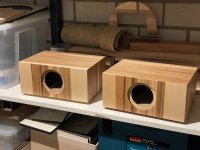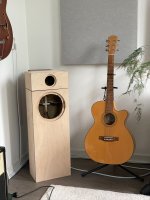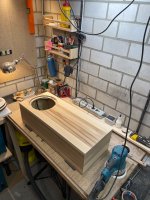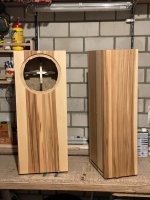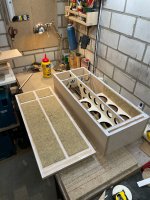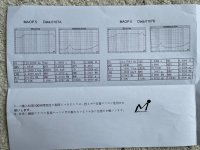Hi everyone,
I am planning on building WAW speakers and I am looking for some advice.
Goals & Context
Here is some of the things I'd like to do in no particular order:
Where I am so far
I've been both drawing up some sketches for aesthetics and playing around with Hornresp to get some feeling for what is possible. Nothing is decided yet but I am aiming for something like below. This particular one is sketched to be 294mm wide, 193mm deep and 770mm. I like this because in my opinion these look 'less heavy' when placed on a stand or legs (which I haven't designed yet), as opposed to a floor-standing tower that reaches all the way to the ground.

So far I've made these decisions:
A Hornresp Rocket?
In Hornresp I currently converged on modelling a vented box for the SB subwoofer with a slight taper, that gave me a response in the 30hz region while remaining the internal volume under 30 L. Here is a few screenshots from one of the configurations I ended up with, just to give you an idea of what I was doing:




Then I started playing around with this configuration and I suddenly ran into this weird configuration where the horn is almost like a rocket. This simulates really well for my purpose and decreased the size of the port somewhat. Not sure if this is something I will do, but I am honestly wondering how this configuration can give such a response? The start of the port feels so incredibly small... Anyone knows what is happening here and if this is something worth exploring further? Some screenshots...



I am planning on building WAW speakers and I am looking for some advice.
Goals & Context
Here is some of the things I'd like to do in no particular order:
- Keep the box relatively small (around 30L max)
- Around 30cm wide baffle max and around 20cm deep (shallow design)
- F3 of 30hz, up to 20khz
- Should work well pushed into corners
- Vented box for the sub for extra extension
- Closed box for the wideband (or better suggestions?)
Where I am so far
I've been both drawing up some sketches for aesthetics and playing around with Hornresp to get some feeling for what is possible. Nothing is decided yet but I am aiming for something like below. This particular one is sketched to be 294mm wide, 193mm deep and 770mm. I like this because in my opinion these look 'less heavy' when placed on a stand or legs (which I haven't designed yet), as opposed to a floor-standing tower that reaches all the way to the ground.
So far I've made these decisions:
- Wideband will be Markaudio MAOP-5s
- Subwoofer will be the SB23MFCL45-4
- I'll use a MiniDSP Flex as a digital XO
- Port on the back
A Hornresp Rocket?
In Hornresp I currently converged on modelling a vented box for the SB subwoofer with a slight taper, that gave me a response in the 30hz region while remaining the internal volume under 30 L. Here is a few screenshots from one of the configurations I ended up with, just to give you an idea of what I was doing:
Then I started playing around with this configuration and I suddenly ran into this weird configuration where the horn is almost like a rocket. This simulates really well for my purpose and decreased the size of the port somewhat. Not sure if this is something I will do, but I am honestly wondering how this configuration can give such a response? The start of the port feels so incredibly small... Anyone knows what is happening here and if this is something worth exploring further? Some screenshots...
In the end I just decided on a slotted port and started building! Here are a few snapshots from the build, currently in the process of oiling the cabinets. I still need to decide on legs / a small stand, but already super excited to experiment with this new setup.
Attachments
Very pretty. I expect M5 is one of the stellar midTweeters, Are you bi-ampinmg?
Hard to believe no-one noticed your original posts.
Called a BVR — big vent reflex. Many examples out there,
When i first saw the pic in Post 1 i thot A26 sealed WAW. But you did very well on your own. How big is your box?


I am partial to modTLs, your sealed approach is fine and much like @waxx A10.3 WAW.
dave
Hard to believe no-one noticed your original posts.
I suddenly ran into this weird configuration where the horn is almost like a rocket
Called a BVR — big vent reflex. Many examples out there,
When i first saw the pic in Post 1 i thot A26 sealed WAW. But you did very well on your own. How big is your box?
I am partial to modTLs, your sealed approach is fine and much like @waxx A10.3 WAW.
dave
I guess I should change my user name to "no-one" then. 😉Hard to believe no-one noticed your original posts.
jeff
Original post was 4 months ago all thefrest today… you are still Jeff ;^)
dave
dave
Last edited:
Yes, for now I am going to manage the XO using a MiniDSP so I can play around a bit. The idea of this speaker build and its setup is that I have a bit of a platform for experimentation. Maybe in the future I will also tryout a PPLXO.Are you bi-ampinmg?
Thanks for clarifying! I hadn't come across that yet.Called a BVR — big vent reflex. Many examples out there,
Wow, those A26s look very pretty. I really love wide baffles like this. Are they deliberately trapezium shaped for them to go into a corner space efficiently?When i first saw the pic in Post 1 i thot A26 sealed WAW. But you did very well on your own. How big is your box?
In the end, I settled on a relatively compact, shallow design:
FR Enclosure (inner)
Width 264mm
Height 101mm
Depth 170mm
~ 4.5 L
Sub Enclosure (inner)
Width 264mm
Height 691mm
Depth 170mm
~ 28.8 L (system volume without bracing)
Things that I am reflecting on and likely have to do diifferent next time:
- Thicker walls for the box, currently 15mm. The subs baffle is double that, but only on the top half of it around the woofer to keep some extra space.
- The slotted port on the back is very thin, almost impossible to route accurately.
- I am a bit anxious about port velocity at higher level listening, we'll see how that goes.
- Probably lots more, if anyone sees/thinks something please call it out (eager to learn!)
XO using a MiniDSP so I can play around a bit.
I have considered one just for the versatility when designing.
dave
Are they deliberately trapezium shaped for them to go into a corner space efficiently?
They have a very low diffraction signature. Concepot orrowed from my trapezoidal miniOnkens:
This set of pictures of various µFonkenSet trapezoidal miniOnkens.

These are 2.5 litre. I have done them up to 135 litre. Trapezoidal midTLs were inspired bythe ones done for the 35 litre one.
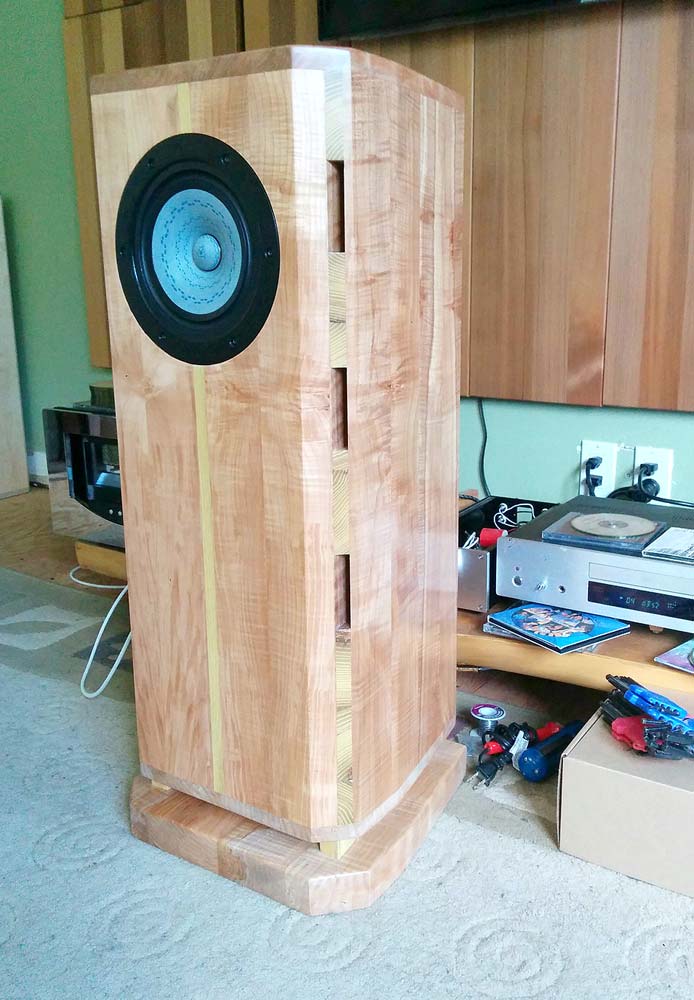
Thicker walls for the box, currently 15mm
Depends on the material and the bracing. We (mostly — Bernie’s builds are all solid wood) used quality plywood. the little boxes can be 12mm but it is easier to work with 15mm. For a 30 litre box we would use 18mm. The exception being push-push subs where 15mm is suffieicnet (at least to 2 x 12”), for practical purpose at least thicker baffles. Push-push takes advantage of the active reaction force cancelation to largely remove any direct energy into the box thru the baffles and one really has to worry about ballooning.
slotted port on the back is very thin,
Very high aspect ratio vents add R to the vents and pushes the box closer to aperiodic. If you are adding subs stuffing the vents pushes them even further.
Our thin vents were just part if the construction. I bborrowed the concept of vents down the sides from the Onken, then took advantage of pushingn them enuff towards aperidoic and came up with my own alignment. If you add a sub really easier to add open cel foam to push them way further aperiodic to make the transition at the bototm easier.
dave
Thanks Dave for all the detailed insights! Really appreciate you taking the time to share your experience.
I also used Baltic birch ply for the build, so that's reassuring to hear. Are there any techniques you'd recommend for determining retrospectively whether a wall thickness is adequate? I'm curious if there are telltale signs (resonances, vibrations, etc.) that would indicate I should have gone thicker with the 15mm walls.
The push-push concept is really intriguing - I love the idea of the active reaction force cancellation. I've seen several implementations but most seem to have the woofers mounted on the sides. I'm personally drawn to having the woofer visible on the front baffle for aesthetic reasons. Have you experimented with front-mounted push-push configurations, or is side-mounting really the only way to do this? I am considering doing an even smaller cabinet push push as the next build, likely also with a smaller budget. Thinking about a WAW with something like the CHN-50.
If I understand correctly, you're suggesting I can still experiment with adding open cell foam to the ports to push the system further toward aperiodic behaviour? That sounds like an interesting way to fine-tune the bass response.
Thanks again for sharing your knowledge!
Willem
I also used Baltic birch ply for the build, so that's reassuring to hear. Are there any techniques you'd recommend for determining retrospectively whether a wall thickness is adequate? I'm curious if there are telltale signs (resonances, vibrations, etc.) that would indicate I should have gone thicker with the 15mm walls.
The push-push concept is really intriguing - I love the idea of the active reaction force cancellation. I've seen several implementations but most seem to have the woofers mounted on the sides. I'm personally drawn to having the woofer visible on the front baffle for aesthetic reasons. Have you experimented with front-mounted push-push configurations, or is side-mounting really the only way to do this? I am considering doing an even smaller cabinet push push as the next build, likely also with a smaller budget. Thinking about a WAW with something like the CHN-50.
If I understand correctly, you're suggesting I can still experiment with adding open cell foam to the ports to push the system further toward aperiodic behaviour? That sounds like an interesting way to fine-tune the bass response.
Thanks again for sharing your knowledge!
Willem
any techniques you'd recommend for determining retrospectively whether a wall thickness is adequate?
Spend ≈ €20 and get a mechanics stehescope and start listenng to the speaker panels (of any looudspeaker you can), Quite revealing. You bracing looks very good. Is the woofer braced against the back?
At low frequencies the woofer is omnidirectional no matter where the driver is or how many there are. This diagram will explain alot.
As long as you XO below the bipole dip you get with woofer fore and aft, how you orient the woofers only matters if they get too close to a wall,
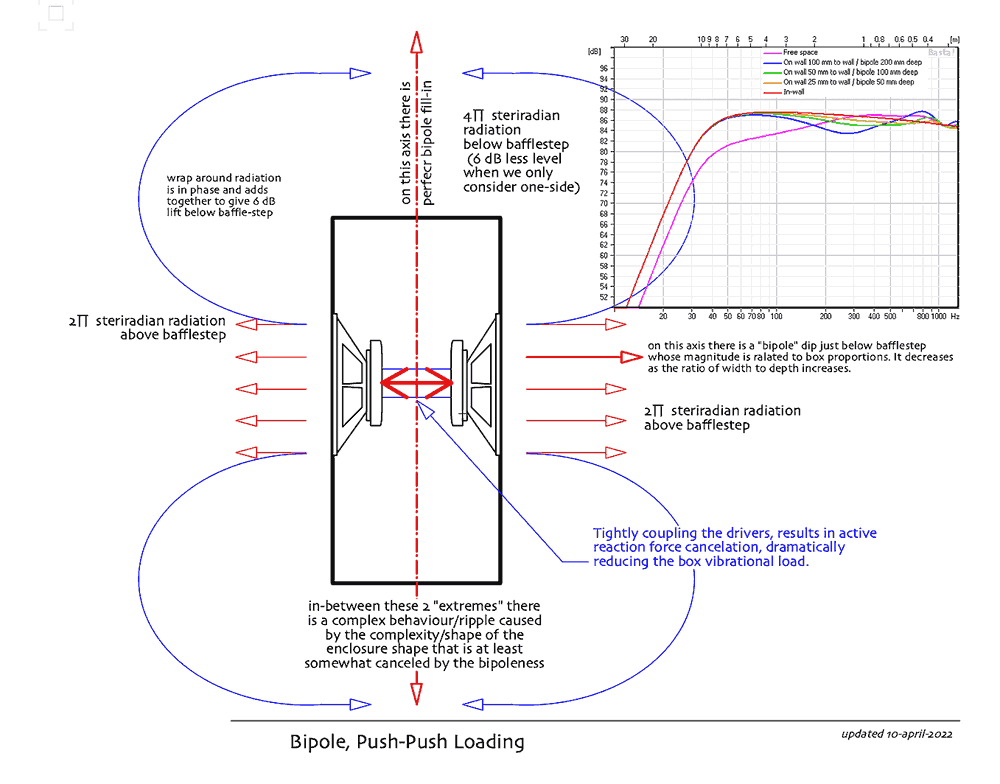
dave
This is such a cool tip! I am going to get one today. The woofer is indeed meant to be braced against the back, but I might need to add a tiny bit of sheet material or something to make it snug against the back.Spend ≈ €20 and get a mechanics stehescope and start listenng to the speaker panels (of any looudspeaker you can), Quite revealing. You bracing looks very good. Is the woofer braced against the back?
The diagram indeed explains a lot. In my case my speakers sadly will always need to be relatively close to the wall because my home is small. Has this been modelled in some software or is it based on real-life extensive testing? Can imagine its hard to predict the output with such a complex push-push setup.
Either way, I am eventually going to build a pair with this technique. Ideally for me the tower would be relatively compact. Curious what other members have created using this push-push setup.
So the drivers have been put into cabinets now, I just need to find some rubber feet to separate the top and bottom unit and then think of a small stand to put them on. I am very happy how they turned out, especially since it was my first time using veneer (excluding 2 small tryouts before the real deal).


The only thing I didn't quiet get right is the corners on this left unit as can be seen from the darker edge on the next picture, but nothing too dramatic in my opinion. Still very happy overall!

The only thing I didn't quiet get right is the corners on this left unit as can be seen from the darker edge on the next picture, but nothing too dramatic in my opinion. Still very happy overall!
Thanks Dave!
I am currently using an old Bluesound Node 2i into the MiniDSP HTx with a PD Creative PSU, then into a Hegel H190 and H390 I bought in a second hand deal (it was a good price, but I still regret buying). I have my eyes set on an Elekit Tube Amp to drive the MAOP and will likely keep one of the Hegels to drive the subwoofer.
I am currently using an old Bluesound Node 2i into the MiniDSP HTx with a PD Creative PSU, then into a Hegel H190 and H390 I bought in a second hand deal (it was a good price, but I still regret buying). I have my eyes set on an Elekit Tube Amp to drive the MAOP and will likely keep one of the Hegels to drive the subwoofer.
That is likely the most magical option from what Ive read so far, but I might eventually go with the 8850 because of its wider tube rolling options and higher output. Im guessing it will be a lesser match for this waw setup specifically, but I do like to experiment and train my ear a bit with all sorts of setups/gear/speakers. So Im currently leaning towards the versatility of the 8850 more…
The drivers are still breaking in but so far the maop sounds pretty darn awesome. Compared to the MS7 which I also have, the sound is a lot less tiring to my ears. So far the soundstage feels a bit further away from me in terms of presentation, the ms7 projects the sound out into the room more. But then again, they really need more breakin time before I can conclude anything.
I have not yet done any measurements (and not much experience with them yet), but as soon as the drivers have a bit more hours on them I am more than willing to try some. I can imagine the outcomes will be very room and system dependent, but anything you’d like to see specifically?
I have not yet done any measurements (and not much experience with them yet), but as soon as the drivers have a bit more hours on them I am more than willing to try some. I can imagine the outcomes will be very room and system dependent, but anything you’d like to see specifically?
Today I hooked up a tube amp (Audio Note OTO SE Sign.) to the MAOP-5 instead of a Hegel. The woofer is still being powered by the other Hegel... Boy oh boy... Night and day, it was already pretty good but with this tube amp everything is on another level. Currently experimenting with crossover settings. Haven't done any measurements yet, but just tuning on the ear I feel somewhere between 250hz and 300hz seems to be very nice.
So far I seem to have a preference for cutting of the MAOP-5 at around 250hz, while doing the woofer at 300hz with different filters even:

While for example this sounds slightly more dull to me:

I am not really someone for a 'flat frequency response' so likely my prefs because of some added warmth, not sure yet...
As I iterate and experiment I will be posting some of my thoughts, findings and measurements here 🙂
So far I seem to have a preference for cutting of the MAOP-5 at around 250hz, while doing the woofer at 300hz with different filters even:
While for example this sounds slightly more dull to me:
I am not really someone for a 'flat frequency response' so likely my prefs because of some added warmth, not sure yet...
As I iterate and experiment I will be posting some of my thoughts, findings and measurements here 🙂
- Home
- Loudspeakers
- Multi-Way
- Questions & Advice for a MAOP 5 WAW
